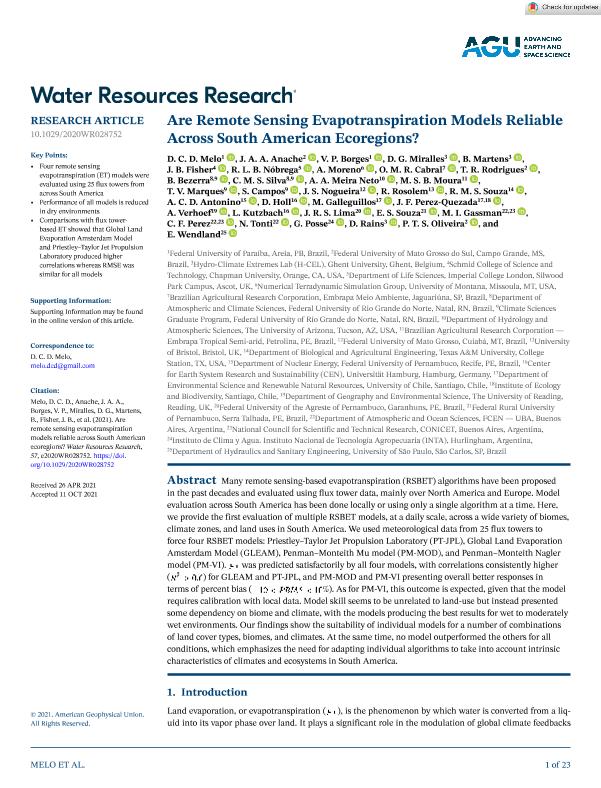Artículo
Are remote sensing evapotranspiration models reliable across South American ecoregions?
Melo, D. C. D.; Anache, J. A. A.; Borges, V. P.; Miralles, D. G.; Martens, B.; Fisher, J. B.; Nóbrega, R. L. B.; Moreno, A.; Cabral, O. M. R.; Rodrigues, T. R.; Bezerra, B.; Silva, C. M. S.; Meira Neto, A. A.; Moura, M. S. B.; Marques, T. V.; Campos, S.; Nogueira, J. S.; Rosolem, R.; Souza, R. M. S.; Antonino, A. C. D.; Holl, D.; Galleguillos, M.; Pérez Quezada, J. F.; Verhoef, A.; Kutzbach, L.; Lima, J. R. S.; Souza, E. S.; Gassmann, María Isabel ; Perez, Claudio Fabian
; Perez, Claudio Fabian ; Tonti, Natalia Edith
; Tonti, Natalia Edith ; Posse, G.; Rains, D.; Oliveira, P. T. S.; Wendland, E.
; Posse, G.; Rains, D.; Oliveira, P. T. S.; Wendland, E.
 ; Perez, Claudio Fabian
; Perez, Claudio Fabian ; Tonti, Natalia Edith
; Tonti, Natalia Edith ; Posse, G.; Rains, D.; Oliveira, P. T. S.; Wendland, E.
; Posse, G.; Rains, D.; Oliveira, P. T. S.; Wendland, E.
Fecha de publicación:
11/2021
Editorial:
American Geophysical Union
Revista:
Water Resources Research
ISSN:
0043-1397
Idioma:
Inglés
Tipo de recurso:
Artículo publicado
Clasificación temática:
Resumen
Many remote sensing-based evapotranspiration (RSBET) algorithms have been proposed in the past decades and evaluated using flux tower data, mainly over North America and Europe. Model evaluation across South America has been done locally or using only a single algorithm at a time. Here, we provide the first evaluation of multiple RSBET models, at a daily scale, across a wide variety of biomes, climate zones, and land uses in South America. We used meteorological data from 25 flux towers to force four RSBET models: Priestley–Taylor Jet Propulsion Laboratory (PT-JPL), Global Land Evaporation Amsterdam Model (GLEAM), Penman–Monteith Mu model (PM-MOD), and Penman–Monteith Nagler model (PM-VI). urn:x-wiley:00431397:media:wrcr25611:wrcr25611-math-0001 was predicted satisfactorily by all four models, with correlations consistently higher (urn:x-wiley:00431397:media:wrcr25611:wrcr25611-math-0002) for GLEAM and PT-JPL, and PM-MOD and PM-VI presenting overall better responses in terms of percent bias (urn:x-wiley:00431397:media:wrcr25611:wrcr25611-math-0003%). As for PM-VI, this outcome is expected, given that the model requires calibration with local data. Model skill seems to be unrelated to land-use but instead presented some dependency on biome and climate, with the models producing the best results for wet to moderately wet environments. Our findings show the suitability of individual models for a number of combinations of land cover types, biomes, and climates. At the same time, no model outperformed the others for all conditions, which emphasizes the need for adapting individual algorithms to take into account intrinsic characteristics of climates and ecosystems in South America.
Palabras clave:
MODIS
,
PENMAN-MONTEITH
,
PRIESTLEY-TAYLOR
,
TRANSPIRATION
Archivos asociados
Licencia
Identificadores
Colecciones
Articulos(OCA CIUDAD UNIVERSITARIA)
Articulos de OFICINA DE COORDINACION ADMINISTRATIVA CIUDAD UNIVERSITARIA
Articulos de OFICINA DE COORDINACION ADMINISTRATIVA CIUDAD UNIVERSITARIA
Citación
Melo, D. C. D.; Anache, J. A. A.; Borges, V. P.; Miralles, D. G.; Martens, B.; et al.; Are remote sensing evapotranspiration models reliable across South American ecoregions?; American Geophysical Union; Water Resources Research; 57; 11; 11-2021; 1-23
Compartir
Altmétricas



